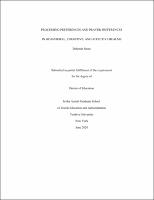Please use this identifier to cite or link to this item:
https://hdl.handle.net/20.500.12202/6358Full metadata record
| DC Field | Value | Language |
|---|---|---|
| dc.contributor.advisor | Pelcovitz, David | |
| dc.contributor.advisor | Goldmintz, Jay | |
| dc.contributor.advisor | Sokolow, Moshe | |
| dc.contributor.author | Stone, Deborah | |
| dc.date.accessioned | 2020-11-10T17:05:17Z | |
| dc.date.available | 2020-11-10T17:05:17Z | |
| dc.date.issued | 2020-06 | |
| dc.identifier.citation | Stone, D. (2020, June) Processing preferences and prayer preferences in behavioral, cognitive, and affective realms. (Publication No. 28774944) [Doctoral dissertation, Yeshiva University]. PQDT | en_US |
| dc.identifier.uri | https://hdl.handle.net/20.500.12202/6358 | |
| dc.identifier.uri | https://ezproxy.yu.edu/login?url=https://www.proquest.com/dissertations-theses/processing-preferences-prayer-behavioral/docview/2635468136/se-2?accountid=15178 | |
| dc.description | Doctoral dissertation, Ed.D., Azrieli Graduate School of Jewish Education and Administration, Open Access. | en_US |
| dc.description.abstract | Prayer is a central religious and spiritual aspect of Jewish Orthodox life and religious education. There are significant challenges in balancing religious obligation (i.e. adherence to religious laws) with individual spiritual personalization. Adolescent development is characterized by individuation and search for personal meaning. Previous studies have explored adolescent development and attitudes toward prayer but have not explored personal preferences as it relates to prayer. This quantitative study was designed to understand the relationship between individual processing preferences and personal preferences concerning prayer behaviorally, cognitively and affectively. 160 students from two Modern Orthodox Middle schools completed an online survey containing 52 items assessing their prayer preferences. The subjects’ preferences were evaluated using three tools, the Prayer Inventory Measure and the Prayer Commentary Measure (Stone, 2020) as well as the VARK© online survey (© Copyright Version 8.01 (2019) held by VARK Learn Limited, Christchurch, New Zealand). Standard statistical analyses were employed to measure the relationship between processing preferences as measured by the VARK measure and prayer preferences as measured by the other two measures. The study found that frequency of prayer behaviors was more closely related to processing preferences than a preference for a prayer behavior. Some significant relationships between processing preferences and cognitive prayer preferences were found, less were found for affective prayer preferences. The data reveled a number of relationships between processing preferences and prayer preferences, however not all findings make a case that processing preferences are a strong indicator for prayer. Nevertheless, some findings indicated that attention to a students’ processing preference may be helpful in considering how to teach and learn about prayer and an individual connection to God. | en_US |
| dc.language.iso | en_US | en_US |
| dc.rights | Attribution-NonCommercial-NoDerivs 3.0 United States | * |
| dc.rights.uri | http://creativecommons.org/licenses/by-nc-nd/3.0/us/ | * |
| dc.subject | doctoral dissertation | en_US |
| dc.subject | religious education | en_US |
| dc.subject | tefillah | en_US |
| dc.subject | Jewish prayer | en_US |
| dc.subject | processing preferences | en_US |
| dc.title | Processing preferences and prayer preferences in behavioral, cognitive, and affective realms | en_US |
| dc.type | Dissertation | en_US |
| Appears in Collections: | Azrieli Graduate School of Jewish Education & Administration: Doctoral Dissertations | |
Files in This Item:
| File | Description | Size | Format | |
|---|---|---|---|---|
| D. Stone Final Dissertation OA.pdf | 2.1 MB | Adobe PDF |  View/Open |
This item is licensed under a Creative Commons License

